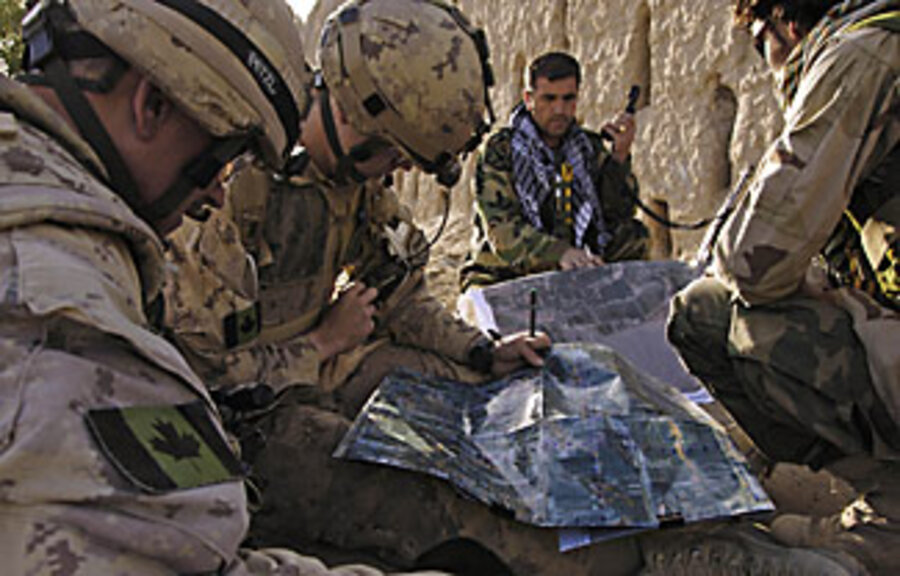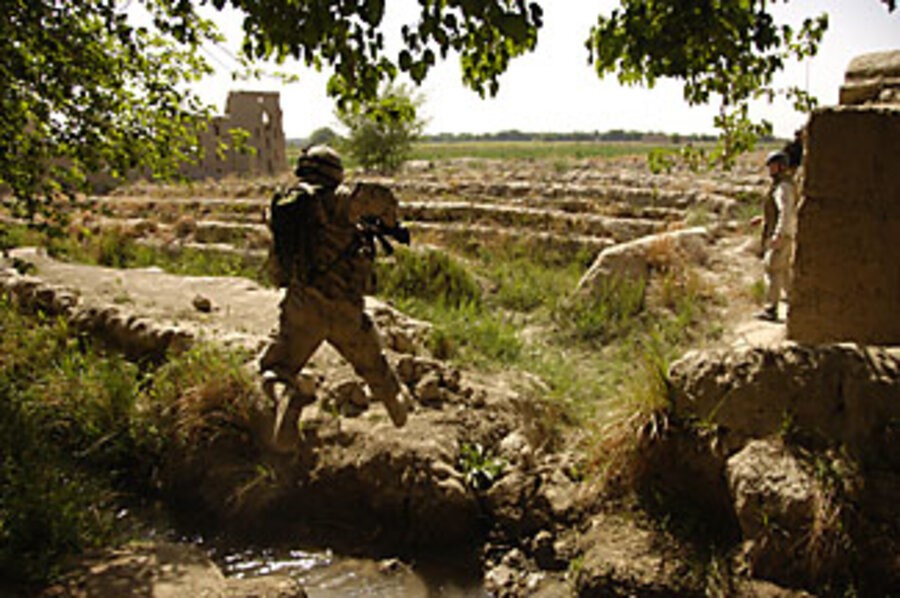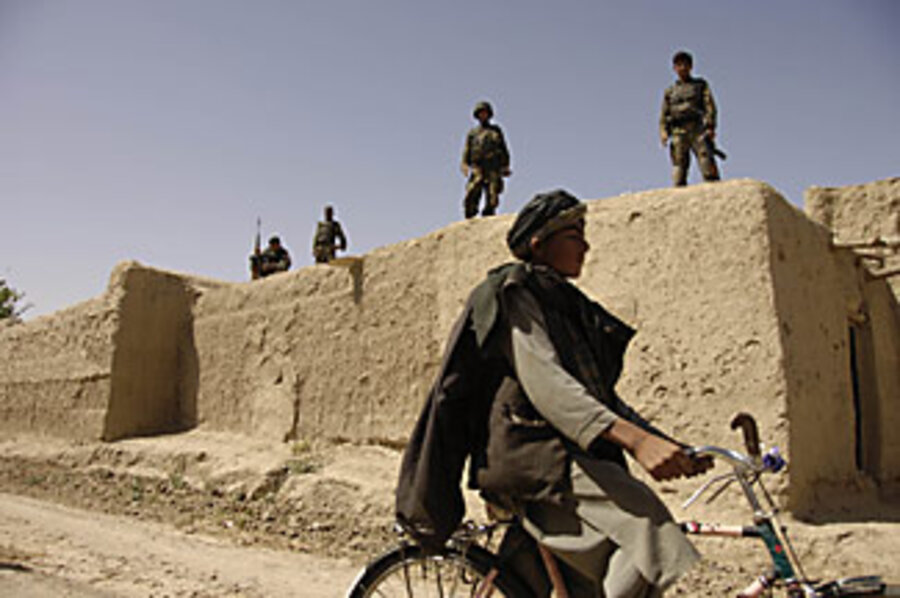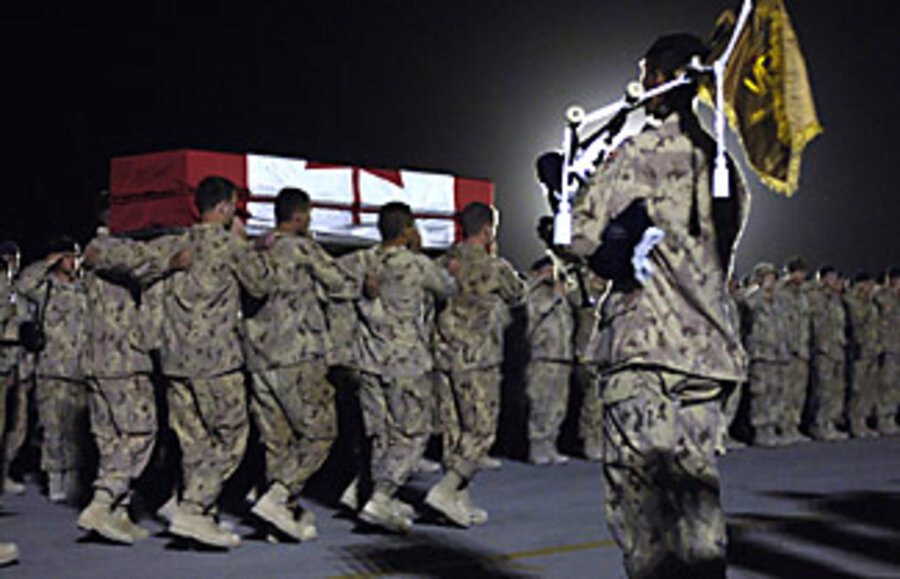An Afghan officer, NATO behind him, leads an assault
Loading...
| ZHARI DISTRICT, Afghanistan
It is just after dawn when the Afghan soldiers creep into lush fields splashed with morning light. Their job is to turn back an insurgency whose members lurk among the grapevines, almond trees, and red-flowered poppy fields that border their military compound. Today, that means stopping a stream of attacks that has disrupted supply routes here in Kandahar Province, in the troubled southern reaches of Afghanistan.
As the men move through the vegetation, only a rooster's crowing breaks the enduring silence, suggesting that the mission may prove a bust. But then gunfire shatters an otherwise pristine morning – and Lt. Col. Sheren Shah, the Afghan commander, grabs the phone strapped to his radio operator and starts barking orders in Pashto.
In the tug of war between the increasingly robust Afghan Army and a potent – if much smaller – enemy, Colonel Shah is the kind of commander that his Canadian advisers like. Shah has earned a reputation for moving quickly, sometimes spearheading a mission just after receiving last-minute intelligence. In response, the Canadians have given him considerable latitude, deferring to him as commander even as they provide essential support.
On this day, after a brief lull in the gunfire, Shah directs his men to send a barrage of small arms fire and rocket-propelled grenades that fills the morning air as they move toward what they believe is an insurgent safe house.
As they observe Shah's operation, the dozen or so Canadians advising this mission say the Army has come far in the past five years. But while wars in Afghanistan have imbued at least two generations of Afghans with a warrior spirit and strong sense of nationalism, the soldiers still lack key discipline and organizational skills. And, as the summer season approaches, opening the door to more aggressive fighting, the Afghans are fighting as a modern army trying to fight an opponent schooled in very different ways.
"The [Afghan National Army] has potential to face the challenges of face-to-face war if the spring offensive happens to have the form of conventional war," says Ahmad Idrees Rahmani, a cofounder of Afghanistan's Center for Research and Policy Studies in Kabul. "The problem of the war against the Taliban is that [conventional warfare] is not their fighting strategy. Each time they take over a district, the ANA and other forces can easily take them out in a few days."
Trouble begins, he adds, "when they retreat and attack in the form of guerrilla fighters. Then it becomes hard to find a fish in the sea of people."
But with disagreement persisting over NATO force levels and longer-term commitments, the Canadians here in Kandahar are under pressure to "stand up" an effective Afghan force that can ultimately step into Western forces' shoes.
The south: longstanding hot spot
As the home of the Taliban and its one-time guest Osama bin Laden, southern Afghanistan has long posed a major challenge to Afghan and NATO coalition forces. Routed in 2001 by US forces, the Taliban and other insurgents have made a comeback: Roadside bombs and suicide bombers are on the rise. Sunday's attempted assassination of President Hamid Karzai in Kabul also serves to remind the Afghan Army of a determined enemy.
Complicating a decisive response in Afghanistan has been the shape of the NATO coalition. It has often failed to coordinate sufficiently, critics say, to stop an enemy that is estimated to be perhaps a sixth of the coalition size. Forty nations have contributed to a force of 61,000, including the American contingent as well as 28,000 other NATO troops.
Indeed, US military officers here often say that the US and its coalition allies haven't been in Afghanistan for seven years, but for one year – seven times. It's a nod to the sentiment that the coalition keeps reinventing the wheel in the troubled country.
Many express hope that fresh thinking about training may move the Afghan Army forward more aggressively. For now, a key driver in Afghan operations here are members of the Operational Mentoring and Liaison Teams, training teams that have evolved in recent years along with the broader mission. The teams are led by commanders like Maj. Bob Ritchie, who's in charge of the Canadian team in Zhari.
Spurred in part by Canadian voters still at odds over the mission in Afghanistan, senior Canadian officials here say they have begun the transition from security-oriented operations in which they do the heavy lifting toward a greater emphasis on Afghan responsibility.
The recent NATO summit in Bucharest included France's formal announcement that it would send more troops and other commitments from additional countries.
Meanwhile, the arrival of the US Marines in the south, and the promise of more American forces to come by 2009, assuaged the Canadians, who had threatened to pull out of the mission if reinforcements weren't sent.
There remains, however, a critical need for dozens more training teams, say NATO officials.
Logistical shortcomings
Critics say the approach to training here under the embedded training teams is still uneven. Despite efforts to ensure uniformity across the training teams, each of the militaries nonetheless approaches mentoring from different perspectives. And US officers who have spent time here say there is little effort to share information, or in military parlance, spread "lessons learned" based on each teams' experiences. "Everyone does something a little different," says one Canadian officer.
The Afghan Army, for example, still is not able to perform many logistical functions like using its nascent intelligence service, fully planning a mission, or providing its ground forces the air support it needs. The intelligence that comes from the Afghan service, for example, can fall prey to political vendettas as Army or police commanders settle debts by politicizing what they put out.
Still, in the middle of a hodgepodge of foreign forces, the Afghan National Army has quietly grown more capable. Coalition forces say part of their job is to make that point to average Afghans – instilling a confidence in them that their national Army is up to the task.
That means making more of an effort to put an "Afghan face" on the fight against the Taliban and other militias.
Needed: good commanders
More than 30 years of war have deprived Afghanistan of many good military commanders. With a 20 percent national literacy rate, little materiel, and lack of professional training, even the good ones can't function at a high level. Afghan fighters' ability to famously beat back their Russian invaders in the 1980s only came with weapons and other support provided covertly by the US and other allies.
While no leader is without his flaws, Shah, who joined the mujahideen to fight the Russians after they killed his father, gets high marks from the Canadians. Tall, abrupt in speech, and handsome, he has courage and force of will, advisers here say. Still, Shah will need the institutional knowledge of his Canadian advisers for his mission amid the poppies and fruit trees.
That doesn't seem to bother him. "It takes time," Shah said the day before, referring to attaining the skills needed to fully direct the show.
For Shah's men, all of whom have been through some form of basic Army instruction, their training largely will end with this day's operation.
As the morning progresses, the Afghan commander and a battalion of about 200 men fan out in two directions along rows upon rows of mud walls that prop up the farmers' plants but make it difficult to see. The supply line they're trying to secure is a small dirt road barely big enough for a small pickup, but used by large flatbed trucks to transport food, ammunition, and other supplies to small bases throughout these fields.
The insurgent safe house they target is thought to have six men inside. Later, it's found to be a small bombmaking factory. Directing his men by radio from an abandoned earthen compound less than a mile away, Shah aligns two rifle companies around the building.
With the help of the Canadians, Shah orders his men to flush out the house. At his side is Major Ritchie, who tips the battle on the ground by calling in an airstrike. In minutes, an unmanned US plane known as a Reaper drops a 300-pound bomb on the house, killing five men. The firefight continues as the soldiers pursue a sixth man who has run away.
It is later learned that one of the dead men is Loy Lala, whom the Canadians and Afghans had been looking for for some time. Shah's men find motorcycles used by the dead insurgents and Shah decides they should be burned.
Ritchie cautions against exploding gas tanks in the middle of the mission, but his objections are overruled by Shah. He wants to prevent them from being used again – but also is eager to allow his men to leave a pointed reminder that they won this battle.
Later, as Shah's men reposition themselves, another group of Taliban is found in the green thicket. But the Afghan forces don't move quickly enough. Ritchie makes another call and a British Harrier Jump Jet arrives, flying low in a show of force, but fails to flush them out.
Ritchie, who has been talking almost nonstop on his radio to his men and coordinating troop movements and airstrikes, marvels that British, US, Canadian, and Afghan forces have all worked on this mission. "Four countries contributing to do the right thing," he says.
Shah's men ultimately find a cache of weapons, including two recoilless rifles used to harass Canadian-Afghan police substations in the area. Shah is ecstatic.
"This is good, Colonel," Ritchie says.
Supply trucks rumble forward
With the area now at least temporarily safe, the coalition supply trucks are able to make it through to a secure compound, and the soldiers receive their rations: ammo, cooking oil, fresh onions, bags of flour, and two sides of beef wrapped loosely in garbage bags.
Today's operation has been a success, says Col. Jean-François Riffou, who oversees all the Canadian adviser teams here, as he watches the operation from inside an earthen compound. "Things are under control, nobody hurt, got some bad guys, and [Shah] is acting deliberately," says Colonel Riffou. Still, the Canadians know he needs more gear, intelligence, soldiers – and practice.
For the Afghans, the sense of accomplishment shows in the visible pride of the men surrounding a beaming Shah. As far as he is concerned, the only thing he needs is not quite within reach. Asked when he could perform a mission like that of today's on his own, Shah nods at the sky and smiles.
"When I get control of the aircraft," he says.









